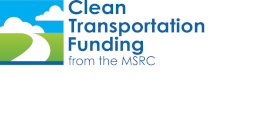FirstCNG officially opened its flagship natural gas fueling station in February in the City of Lake Forest in Orange County, with the help of Clean Transportation Funding from the MSRC. Titan NGV Fueling Station is located at 24201 El Toro Road conveniently next to the 5 Freeway. The station has four NGV-2 dispenser nozzles, so customers do not have to wait to fuel up. In fact, the station is so busy that during the ribbon-cutting ceremony to officially open the station, the ceremonies were continuously interrupted by a constant stream of customers wanting to fuel their vehicles.
Now that the station is open, it’s off to a great start. But getting there was a little challenging, explained Kirk Honour, FirstCNG’s CEO, who has been working on this project for a little over three years. “It was quite an undertaking to get this project completed.” Initially, FirstCNG chose a site for the station that was very close to the John Wayne Airport. They selected this location because there was a large user-base of natural gas in the area, as the taxis servicing the airport all run on CNG, providing a market for them to develop a successful retail location.
FirstCNG wasn’t able to come to terms on the original location, but then the El Toro site became available. “The El Toro property is one of the only CNG stations that’s truly a “gas” station,” Kirk said. The property was a gas station 20 years ago, so its footprint was ideal for a new CNG fueling station. Everybody we’ve talked to loves the fact that we’re a dedicated natural gas station that is set up like the traditional gas stations that surround it. The station is very easy to access and not tucked away in a back alley behind a building like many CNG stations.”
“The station is also right off of the 5 Freeway, so it is still close enough to the airport to capture the airport traffic,” noted Kirk. He’s spoken with many of the local cab drivers that use the station and they have told him that they stop to fill up every time they pass the station.
In addition to other funding, FirstCNG received a $150,000 grant from MSRC. “Having grant funding really helped us develop the project,” he commented. Based in Minnesota, FirstCNG learned about the MSRC through a technology research trip to Argentina. “We went to Argentina to learn about a local company’s natural gas technology, and through this process, we made a local connection with someone who let us know about the funding opportunities with the MSRC,” Kirk explained.
The El Toro station had a soft launch in January 2015. Since its opening, the station has had more than 500 unique site visitors. On average, about two-thirds of the visitors are repeat customers. “The station is a huge success from my standpoint, and we’re looking forward to seeing it grow,” said Kirk.
The station’s system is capable of producing a continuous volume of about 7-8 gallons per minute. FirstCNG’s goal is to do at least 1,000 gallons per day of sales.
The site can accommodate just about any size vehicle, including school buses. Kirk recounted that the Saddleback Valley Unified School District has five natural gas school buses and that prior to the Titan’s station opening, buses had to fuel up at least 8 miles away. Because of this, Kirk explained that some of the drivers didn’t want to use the natural gas buses. Now, the drivers are using the buses more often and the bus operator is even planning to add another five CNG school buses next year. The local waste hauler, CR&R, is also using the station, filling up at least three times per week. Local contractors like HVAC repair, plumbers and house remediation companies fuel their trucks at the station too.
“I knew customers would come out of the woodwork once the station opened, but all of these people I didn’t even know about have been using the station. In fact, many of them live in the area and have told me they have been waiting for the station to open,” Kirk noted. One customer had been waiting for a year and a half for the station to open. “When we finally opened the station she told me, ‘this made my month’, which is pretty awesome to hear.”
Kirk sees the station’s role in helping improve air quality as an important one. “There was a recent report that the air in Los Angeles County and Orange County is better than it was 20 years ago due, in large part, to lower emissions. It’s a testament to the fact that local air agencies are making people healthier through their work in lowering the amount of pollution in the air. Our station, along with the network of other stations, makes a large contribution to this effort because dropping PM out of diesel is where you see a huge difference in reduced emissions.”
He wants to see the use of natural gas continue to grow. “I think the network of natural gas stations in Southern California is going to get denser and, as it does, we can get more natural gas vehicles on the road. I look at all the people driving around, and they want to go wherever they want to go anytime they want to do it - it’s just the American way.” Kirk acknowledged that other vehicle technologies have their place, but he said, “for now, the best way to give people the freedom to drive the way they want is to have cleaner liquid-like fuel - you can get a quick fill up and be on your way.”
